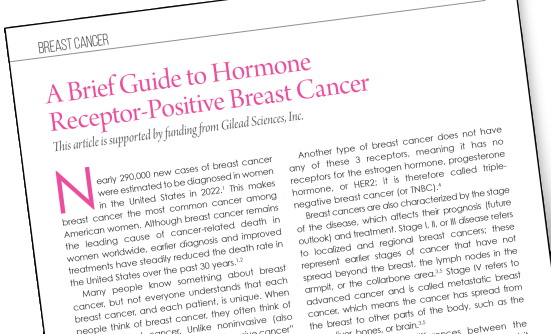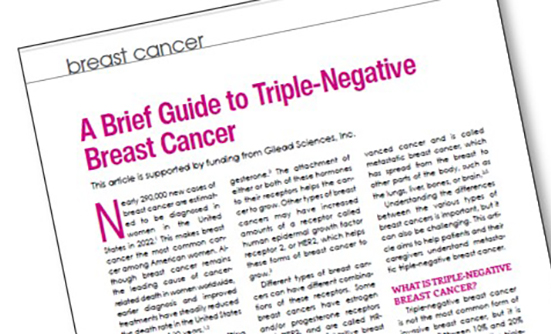The use of the PARP inhibitor Lynparza (olaparib) for 1 year after receiving standard chemotherapy in the neoadjuvant (before surgery) or the adjuvant (after surgery) setting significantly improved the time of survival without signs of cancer (known as “disease-free survival”) in patients with high-risk, early-stage, HER2-negative breast cancer and BRCA1 or BRCA2 mutations, according to results presented at the 2021 ASCO Annual Meeting.
An interim analysis of the phase 3 clinical trial called OlympiA showed that after an average follow-up of 2.5 years, 77.1% of the patients who received standard chemotherapy plus placebo had an estimated 3-year survival without invasive disease (or “invasive disease-free survival”). But this rate increased to 85.9% of patients without invasive disease with the addition of olaparib therapy for 1 year.

These results were presented by lead investigator Andrew Tutt, MBChB, PhD, Director of the Breast Cancer Now Toby Robins Research Centre at the Institute of Cancer Research and Guy’s Hospital in London, England, who presented the study results.
“The OlympiA study results, the first reporting the effects of a PARP inhibitor as an adjuvant therapy on survival end points, suggest a possible addition to the standard of care for patients with germline BRCA1/2 mutation-associated early breast cancer who have levels of recurrence risk requiring neoadjuvant or adjuvant chemotherapy,” Dr. Tutt said.
“The role of olaparib as an adjuvant therapy in any germline BRCA mutation malignancy is untested, and OlympiA sought to examine this in high-recurrence-risk early breast cancer,” said Dr. Tutt.
The OlympiA Study
OlympiA included 1,836 patients with germline BRCA1 or BRCA2 mutations and high-risk early breast cancer without HER2 overexpression. The patients received standard multimodal therapy (including neoadjuvant or adjuvant chemotherapy plus surgery, with or without radiation therapy). Patients were divided to receive either olaparib twice daily or placebo for 1 year.
Most patients (75.8%) in the olaparib group had a mastectomy, as well as 73.6% of the patients in the placebo group, which was consistent with the genetic makeup of the patients, Dr. Tutt said. About 18% of patients had estrogen receptor (ER)-positive breast cancer, and about 82% had triple-negative breast cancer. About 90% of patients with ER-positive breast cancer received endocrine therapy.
The estimated 3-year survival without metastatic disease was 87.5% in the olaparib group and 80.4% in the placebo group. At an average follow-up of 2.5 years, the average overall survival was 3.7% in favor of olaparib compared with the placebo group, but this difference was not statistically significant.
Side Effects
As expected, nausea occurred more frequently in the olaparib arm (57%) compared with the placebo arm (23%), as did fatigue (40% vs 27%), most of which were grade 1 or 2 events. Serious (grade 3 or 4) side effects were few and consisted of mainly anemia (low iron level) and neutropenia (infection).

Change in Practice
“I believe these results are practice changing,” commented Nadine M. Tung, MD, Director of Cancer Risk and Prevention Program and Breast Medical Oncology, Beth Israel Deaconess Medical Center, Dana-Farber/Harvard Cancer Center, Boston, Massachusetts. “The results of OlympiA reinforce the need to identify germline BRCA carriers among those with early-stage breast cancer,” Dr. Tung said.
“In the past, genetic testing was used in this population to manage future cancer risk. Now this information is needed for treatment decisions. Unfortunately, less than half of patients with breast cancer who qualify for germline genetic testing are offered testing. Underutilization is greatest in minority and underserved populations,” Dr. Tung added.
Key Points
- The use of the PARP inhibitor olaparib for 1 year of chemotherapy before or after surgery significantly extended survival without cancer in patients with early-stage breast cancer and BRCA mutation
- These results from the OlympiA study suggest that olaparib may need to be added to the standard of care for patients with early breast cancer and BRCA mutation who require neoadjuvant or adjuvant chemotherapy
- In this study, the estimated 3-year survival without metastatic disease was 87.5% in the olaparib group and 80.4% in the placebo group
- As expected, nausea occurred more frequently in the olaparib arm (57%) compared with the placebo arm (23%), as did fatigue
- Genetic testing is now needed to decide on the best treatment, based on these results
- However, less than half of patients with breast cancer who qualify for genetic testing are offered testing, especially among patients from minority and underserved populations















